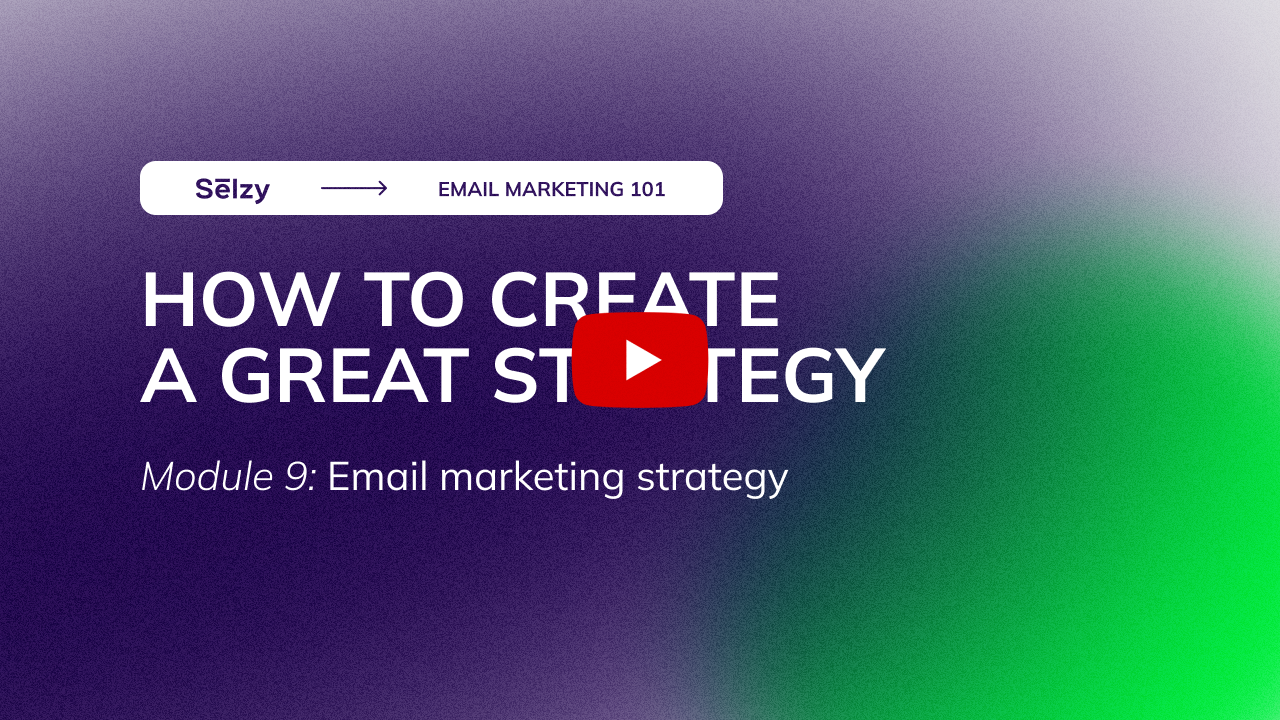Putting Together the Right Strategy for Email Marketing
This is a transcript of lesson 22 of Email Marketing 101 Course by Selzy.

Hello, and welcome to another lesson in our email marketing series! In Module 9, Lesson 1, we’ll teach you how to make the most out of your email marketing efforts.
During this lesson, we’ll explore why having a solid email marketing strategy is crucial. We will cover the tips for establishing your goals, identifying your target audience, studying your competitors, and scheduling your email campaigns.
So, let’s start with why having an email marketing strategy is so important. Simply put, sending emails alone won’t be enough to guarantee success. A well-thought-out strategy will help you focus your efforts, engage your target audience more effectively, and ultimately increase your chances for success.
Now, let’s discuss how to put together the “right” strategy for your email marketing campaigns. We will go over it step-by-step.
Step #1: Determine your goals and target audience
To create a successful email marketing strategy, you must identify your goals and target audience. Start by asking yourself, “What do I want to achieve through email marketing?” The goal may be generating leads, boosting sales, increasing brand awareness, or improving customer engagement and retention. Then you can identify the specific metrics to measure success, such as click-through rates, conversion rates, or revenue generated.

This visual is only available in a video lesson
Once you have identified your goals, it’s essential to understand your target audience. Who are they? What do they like? What do they dislike? What motivates them to take action? Answering these questions will help you create content that resonates with your audience and fosters lasting connections.
One common mistake marketers make is assuming they know their audience without actually taking the time to research and analyze their preferences and behavior. Take the time to gather data about your audience, including demographics, interests, pain points, and challenges. This information will help you create more relevant and valuable content, leading to higher engagement and better results. As you build relationships with your email list, you may find that some segments are more interested in certain types of content than others.
Step #2: Study your competition and learn from their tactics
Keeping tabs on your competitors is an invaluable way to stay ahead of the game.
Sign up for their newsletters and take note of the types of emails they send, their frequency, design elements, and overall tone. Doing so will not only help you identify any gaps in your own strategy, but also inspire innovative ideas to set your campaigns apart from the rest.

This visual is only available in a video lesson
Step #3: Identify the types of emails you should send
Diversifying the kinds of emails you send is crucial for keeping your audience engaged. These may include promotional emails to boost sales, educational content to provide value, or newsletters to keep subscribers informed about your business. By understanding your audience’s preferences, you can tailor your content to their needs, resulting in higher engagement and better results.

This visual is only available in a video lesson
Understanding your target audience’s preferences will help guide your decision-making when choosing which types of emails to send. Remember, variety keeps things interesting, but consistency ensures that your audience knows what to expect from you.
Step #4: Create a schedule for your email campaigns
Sending emails consistently is key to building trust and maintaining engagement with your subscribers. But finding the right frequency and timing can be a challenge. Start by analyzing your audience’s behavior patterns, including when they are most likely to open and engage with your emails. Experiment with different frequencies and track how your audience responds to each change. Adjust as necessary until you find the ideal balance between maintaining their interest and avoiding inbox fatigue.

This visual is only available in a video lesson
By following these steps and continuously iterating and improving your strategy, you can create a highly effective email marketing campaign that resonates with your audience, drives engagement, and achieves your business goals.
Wrap up
In conclusion, crafting the “right” strategy for your email marketing endeavors involves identifying clear goals, understanding your target audience, studying competitors’ tactics, diversifying the types of emails you send, and establishing a thought-out schedule for your campaigns.
Stay tuned for our next lesson, where we will provide insights into optimizing your email marketing strategy to maximize conversions and overall success. Happy strategizing!
This is a transcript of lesson 22 of Email Marketing 101 Course by Selzy.